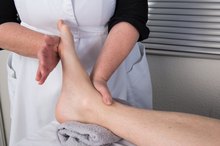Signs & Symptoms of a Torn Tendon in the Foot
Tendons are the tissue that connects muscle and bone. We have four different ones in our feet. The achilles tendon runs along the back of the ankle and calf and is the one most prone to injury. The peroneal tendon wraps around the bottom of the foot. The two tibia tendons sit alongside the ankle on either side of the leg. Torn tendons are usually the result of untreated tendinitis, an inflammation of the tendon that can cause overcompensation in movement leading to more severe damage. Tendintitis is typically caused by muscle fatigue, poor warmup, inappropriate shoes, running on hills or banked track and overtraining. The symptoms are similar for tearing in all four of the foot's tendons.
Pain
Pain from torn tendons can be severe, especially during movement and even normal activity. The pain continues at night while resting. The best way to deal with the pain is to avoid strenuous exercise, take an anti-inflammatory like ibuprofen and see your doctor. He will advise you if the tear will heal on its own or will require surgery. Recovery time could take as much as to six to eight weeks. Hot or cold compresses, according to the doctor’s recommendation, may also be effective at reducing the pain and swelling.
Limited Flexibility
Signs & Symptoms of a Torn Tendon in the Foot
Learn More
A torn tendon can result in stiffness and limited movement of the foot and/or ankle, depending on the tendon that is torn. This stiffness, which starts during tendintitis, is one of the contributing factors to the tendon being torn. According to USA Today Heath, many doctors and therapists recommend self-massage of the area. This may help relieve some of the stiffness, which will keep you form overcompensating and making things worse.
Weakness
Damage to both the peroneal and posterior tibial tendons can result in the inability to stand on your toes due to weakness caused by the tendon damage. A doctor will ask you to stand on your toes and, if you are able to, look to see which direction your heels are pointed. Normally functioning, healthy feet and tendons encourage the heels to point inward, so if yours do not, this could be a sign of tendon damage.
Adult Acquired Flat Foot
How to Increase Flexibility in My Big Toes
Learn More
A torn foot tendon can develop and show itself as flat foot, which is a reduction or destruction of the natural arch of the foot. This can be seen from the back as the appearance of too many toes. Early stages of flat foot respond to orthotic shoes or inserts, but later stages require surgery which fuses bones in the foot together. You can go back to work in a week, but need crutches for one to three months. Total recovery can take as long as a year.









